Management Accounting: Costing Methods and Decision-Making Report
VerifiedAdded on 2023/04/06
|13
|1176
|186
Report
AI Summary
This management accounting assignment solution covers various key concepts and techniques. Part A focuses on cost assignment to cost pools, specifically for Mia's animal shelter, categorizing costs into housing, training, and healthcare services. Part B includes several questions addressing activity-based costing (ABC), support department cost allocation, cost-volume-profit (CVP) analysis, and decision-making related to segment profitability. The ABC analysis identifies appropriate activity drivers for different cost pools. The cost allocation section examines direct, step-down, and reciprocal methods, highlighting the advantages and disadvantages of different allocation bases. The CVP analysis computes break-even points, margin of safety, and sales volume required to achieve target profits, also evaluating the impact of increased advertising costs. Finally, the report assesses the decision to drop a business segment, considering both quantitative and qualitative factors influencing such strategic choices. Desklib provides similar solved assignments and resources for students.
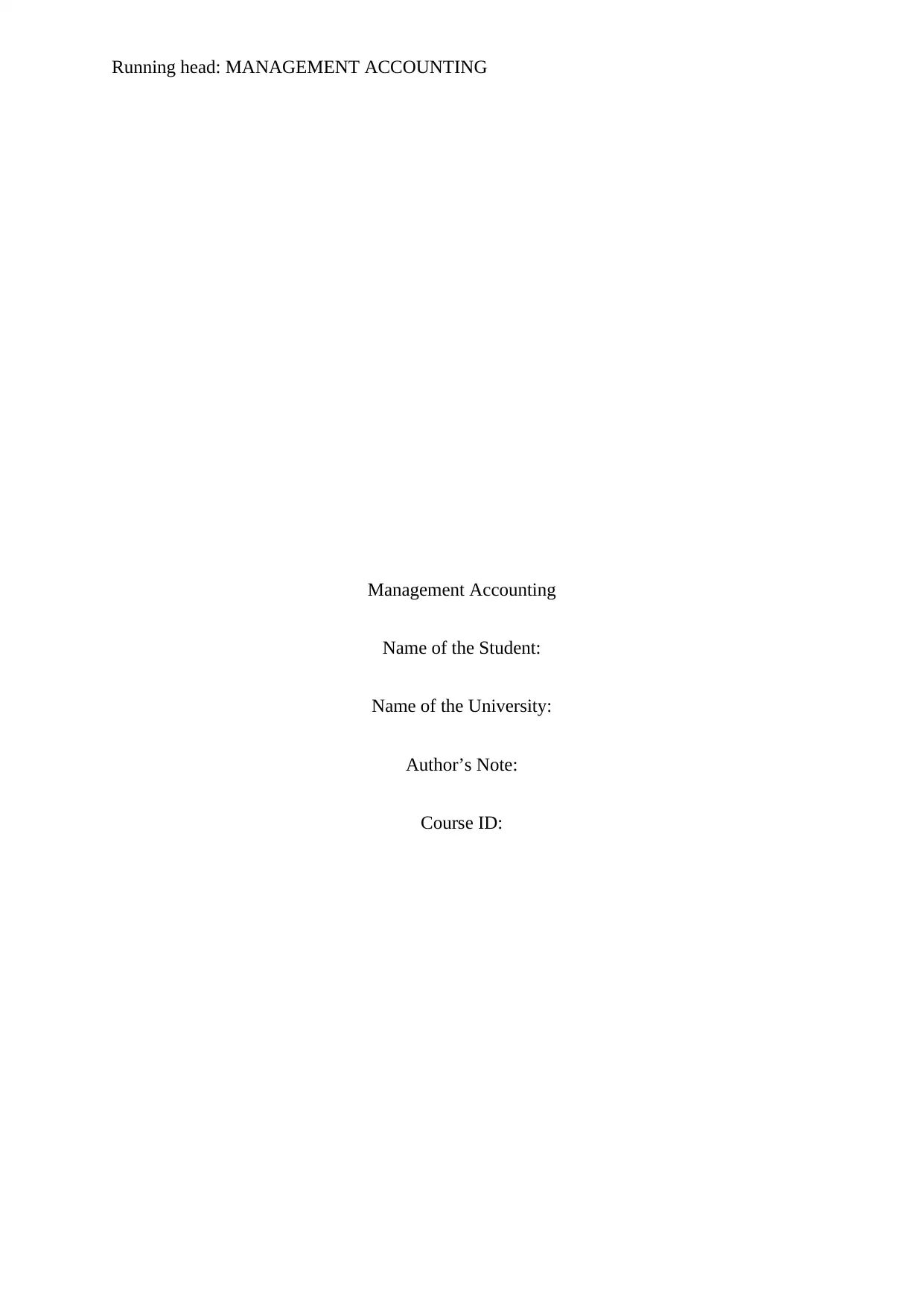
Running head: MANAGEMENT ACCOUNTING
Management Accounting
Name of the Student:
Name of the University:
Author’s Note:
Course ID:
Management Accounting
Name of the Student:
Name of the University:
Author’s Note:
Course ID:
Paraphrase This Document
Need a fresh take? Get an instant paraphrase of this document with our AI Paraphraser
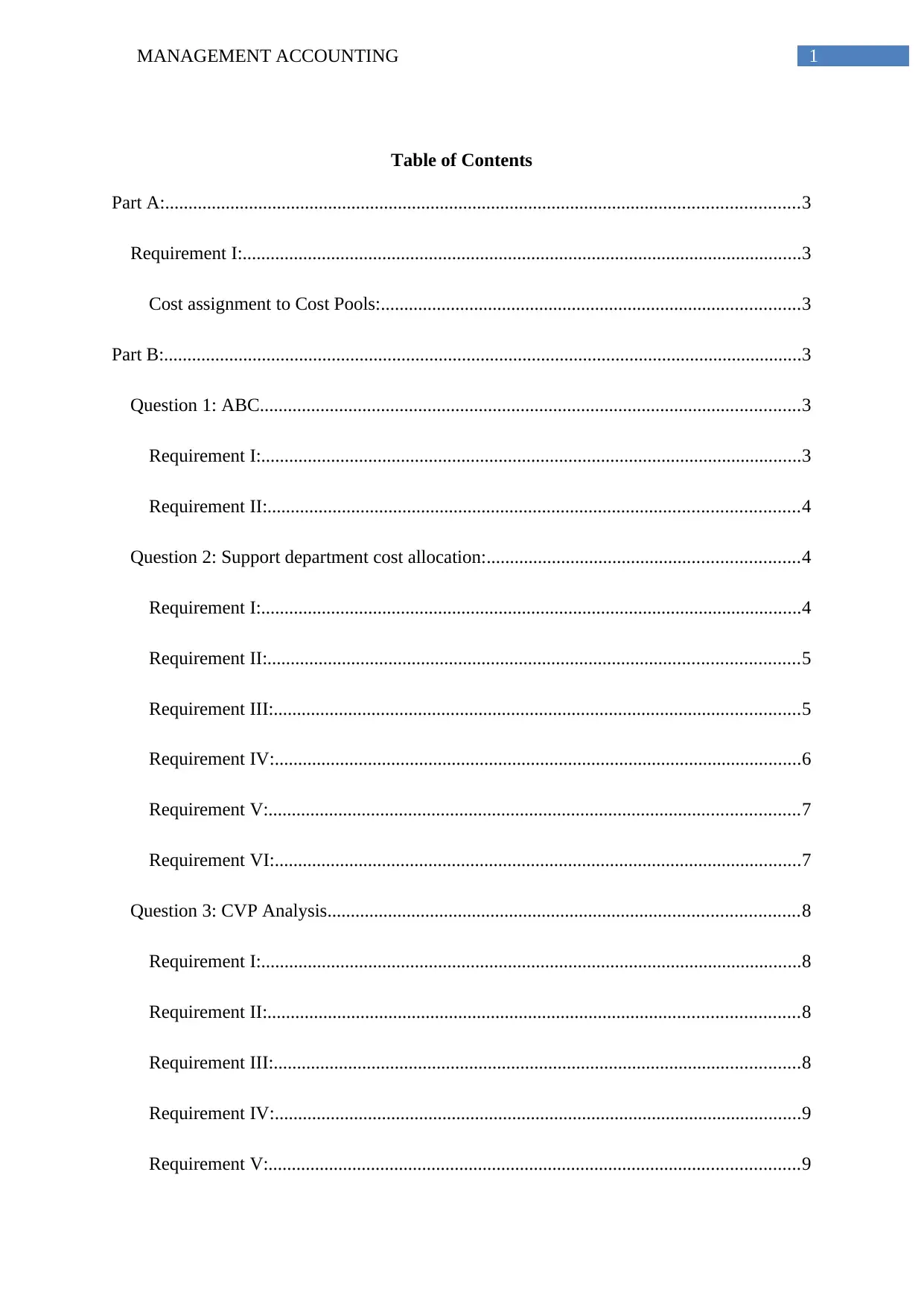
1MANAGEMENT ACCOUNTING
Table of Contents
Part A:........................................................................................................................................3
Requirement I:........................................................................................................................3
Cost assignment to Cost Pools:..........................................................................................3
Part B:.........................................................................................................................................3
Question 1: ABC....................................................................................................................3
Requirement I:....................................................................................................................3
Requirement II:..................................................................................................................4
Question 2: Support department cost allocation:...................................................................4
Requirement I:....................................................................................................................4
Requirement II:..................................................................................................................5
Requirement III:.................................................................................................................5
Requirement IV:.................................................................................................................6
Requirement V:..................................................................................................................7
Requirement VI:.................................................................................................................7
Question 3: CVP Analysis.....................................................................................................8
Requirement I:....................................................................................................................8
Requirement II:..................................................................................................................8
Requirement III:.................................................................................................................8
Requirement IV:.................................................................................................................9
Requirement V:..................................................................................................................9
Table of Contents
Part A:........................................................................................................................................3
Requirement I:........................................................................................................................3
Cost assignment to Cost Pools:..........................................................................................3
Part B:.........................................................................................................................................3
Question 1: ABC....................................................................................................................3
Requirement I:....................................................................................................................3
Requirement II:..................................................................................................................4
Question 2: Support department cost allocation:...................................................................4
Requirement I:....................................................................................................................4
Requirement II:..................................................................................................................5
Requirement III:.................................................................................................................5
Requirement IV:.................................................................................................................6
Requirement V:..................................................................................................................7
Requirement VI:.................................................................................................................7
Question 3: CVP Analysis.....................................................................................................8
Requirement I:....................................................................................................................8
Requirement II:..................................................................................................................8
Requirement III:.................................................................................................................8
Requirement IV:.................................................................................................................9
Requirement V:..................................................................................................................9
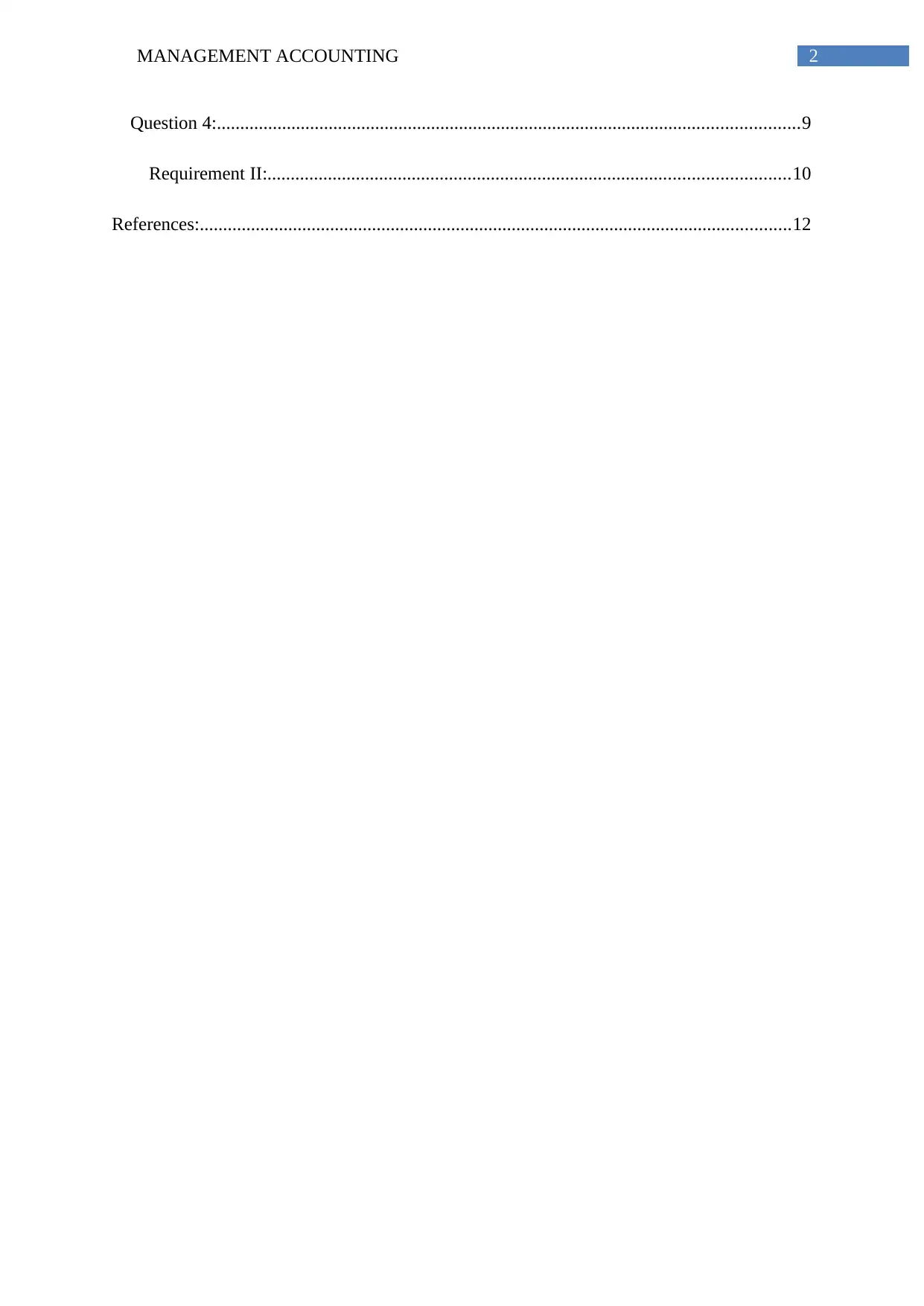
2MANAGEMENT ACCOUNTING
Question 4:.............................................................................................................................9
Requirement II:................................................................................................................10
References:...............................................................................................................................12
Question 4:.............................................................................................................................9
Requirement II:................................................................................................................10
References:...............................................................................................................................12
⊘ This is a preview!⊘
Do you want full access?
Subscribe today to unlock all pages.

Trusted by 1+ million students worldwide
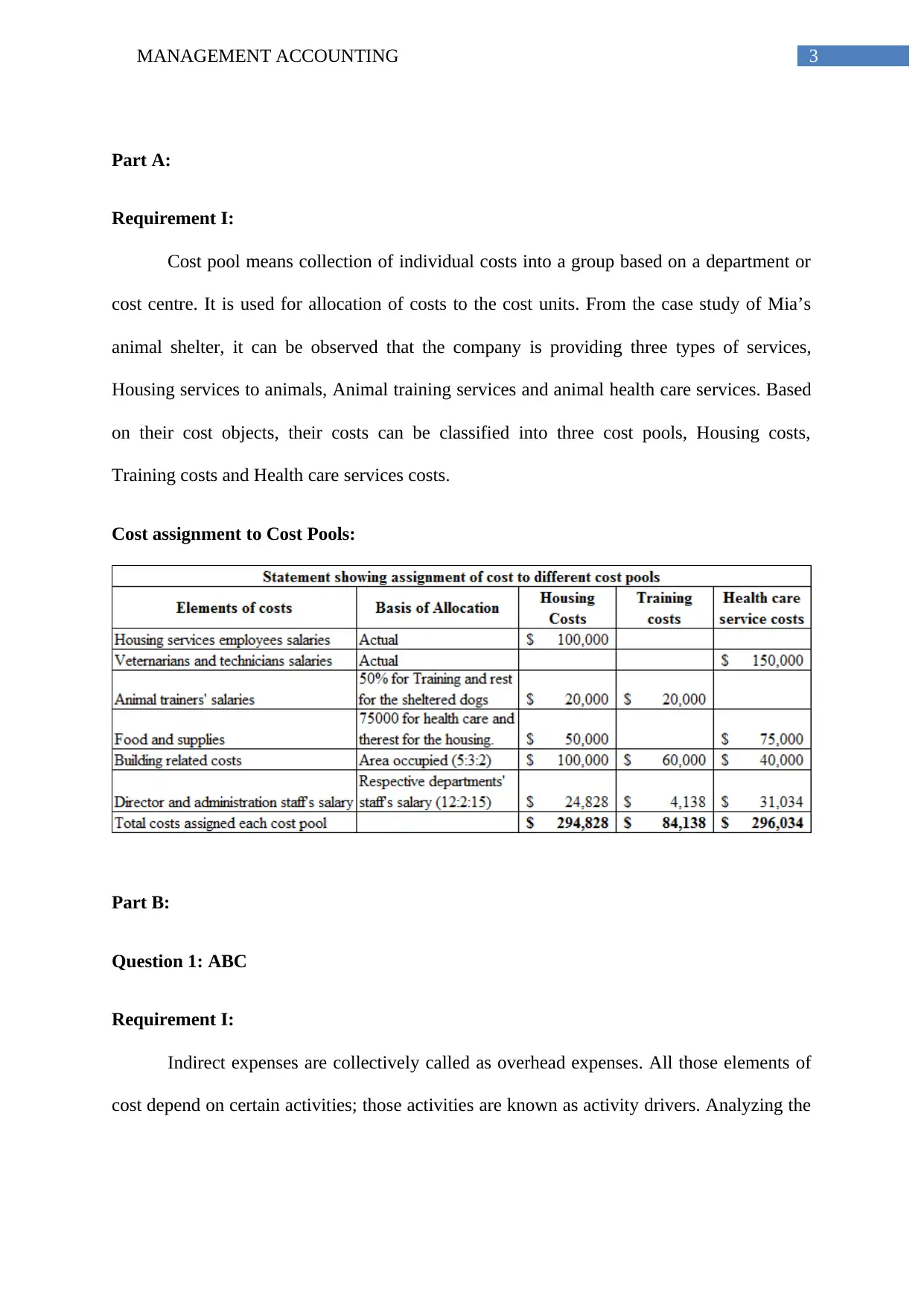
3MANAGEMENT ACCOUNTING
Part A:
Requirement I:
Cost pool means collection of individual costs into a group based on a department or
cost centre. It is used for allocation of costs to the cost units. From the case study of Mia’s
animal shelter, it can be observed that the company is providing three types of services,
Housing services to animals, Animal training services and animal health care services. Based
on their cost objects, their costs can be classified into three cost pools, Housing costs,
Training costs and Health care services costs.
Cost assignment to Cost Pools:
Part B:
Question 1: ABC
Requirement I:
Indirect expenses are collectively called as overhead expenses. All those elements of
cost depend on certain activities; those activities are known as activity drivers. Analyzing the
Part A:
Requirement I:
Cost pool means collection of individual costs into a group based on a department or
cost centre. It is used for allocation of costs to the cost units. From the case study of Mia’s
animal shelter, it can be observed that the company is providing three types of services,
Housing services to animals, Animal training services and animal health care services. Based
on their cost objects, their costs can be classified into three cost pools, Housing costs,
Training costs and Health care services costs.
Cost assignment to Cost Pools:
Part B:
Question 1: ABC
Requirement I:
Indirect expenses are collectively called as overhead expenses. All those elements of
cost depend on certain activities; those activities are known as activity drivers. Analyzing the
Paraphrase This Document
Need a fresh take? Get an instant paraphrase of this document with our AI Paraphraser
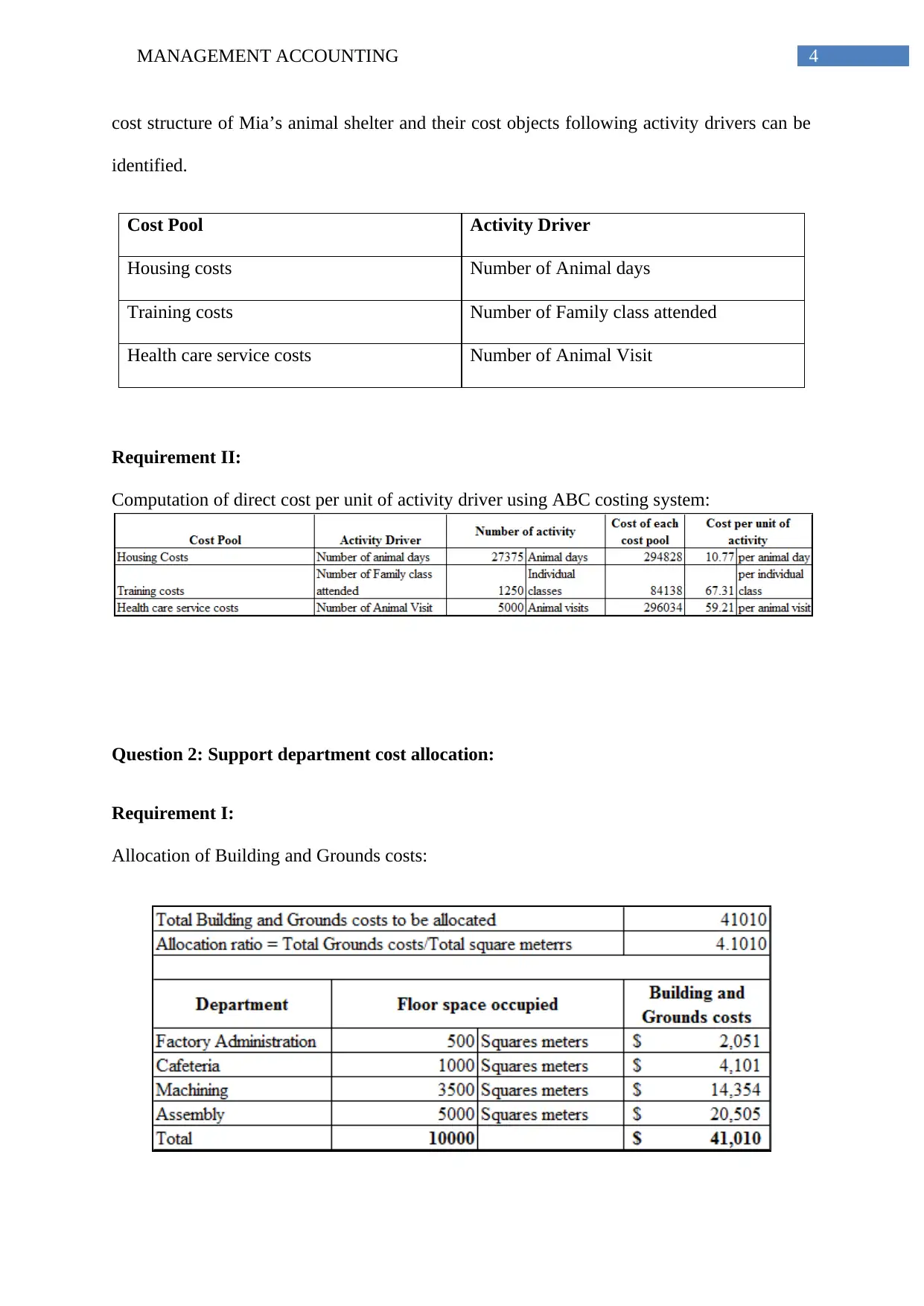
4MANAGEMENT ACCOUNTING
cost structure of Mia’s animal shelter and their cost objects following activity drivers can be
identified.
Cost Pool Activity Driver
Housing costs Number of Animal days
Training costs Number of Family class attended
Health care service costs Number of Animal Visit
Requirement II:
Computation of direct cost per unit of activity driver using ABC costing system:
Question 2: Support department cost allocation:
Requirement I:
Allocation of Building and Grounds costs:
cost structure of Mia’s animal shelter and their cost objects following activity drivers can be
identified.
Cost Pool Activity Driver
Housing costs Number of Animal days
Training costs Number of Family class attended
Health care service costs Number of Animal Visit
Requirement II:
Computation of direct cost per unit of activity driver using ABC costing system:
Question 2: Support department cost allocation:
Requirement I:
Allocation of Building and Grounds costs:
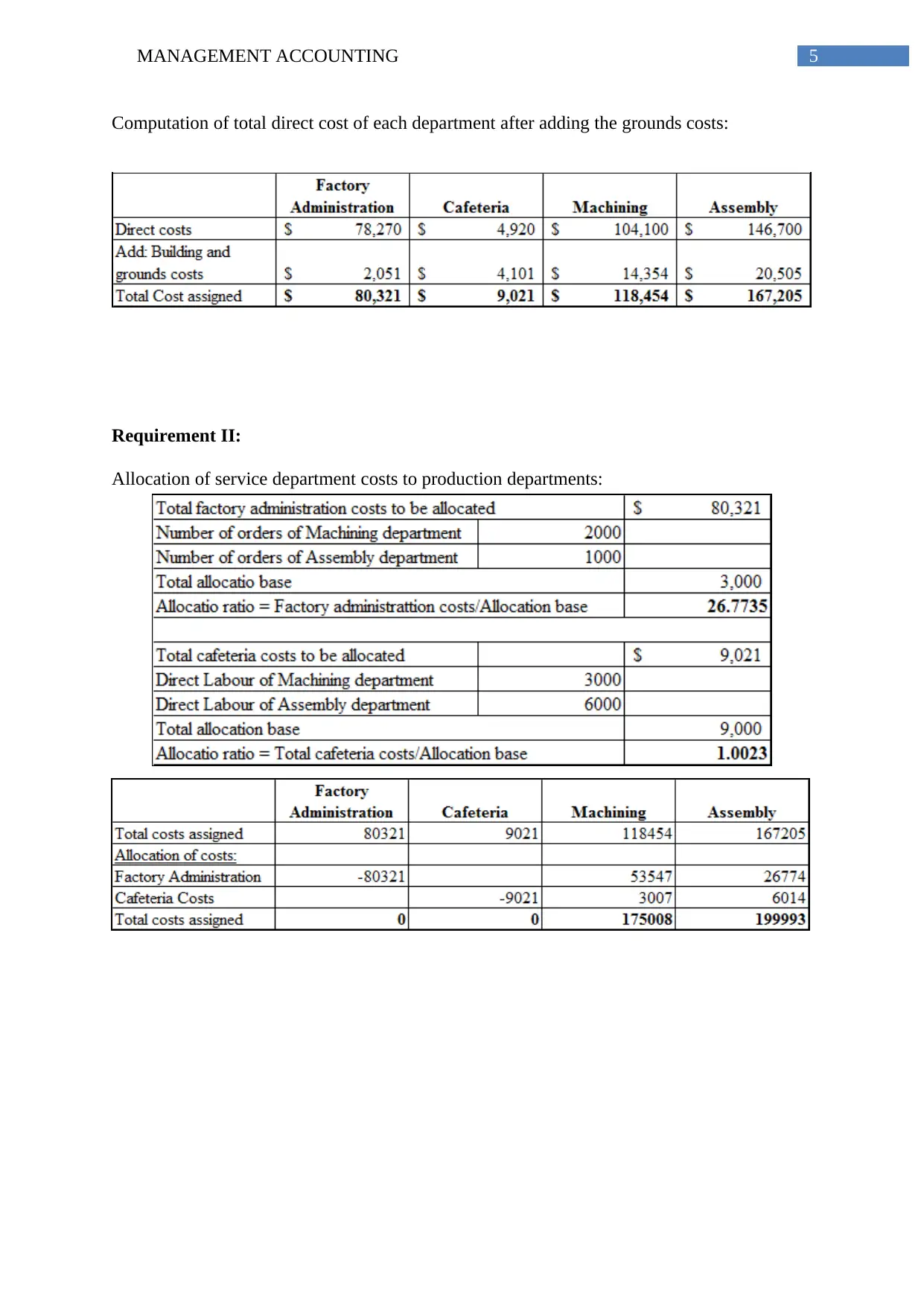
5MANAGEMENT ACCOUNTING
Computation of total direct cost of each department after adding the grounds costs:
Requirement II:
Allocation of service department costs to production departments:
Computation of total direct cost of each department after adding the grounds costs:
Requirement II:
Allocation of service department costs to production departments:
⊘ This is a preview!⊘
Do you want full access?
Subscribe today to unlock all pages.

Trusted by 1+ million students worldwide
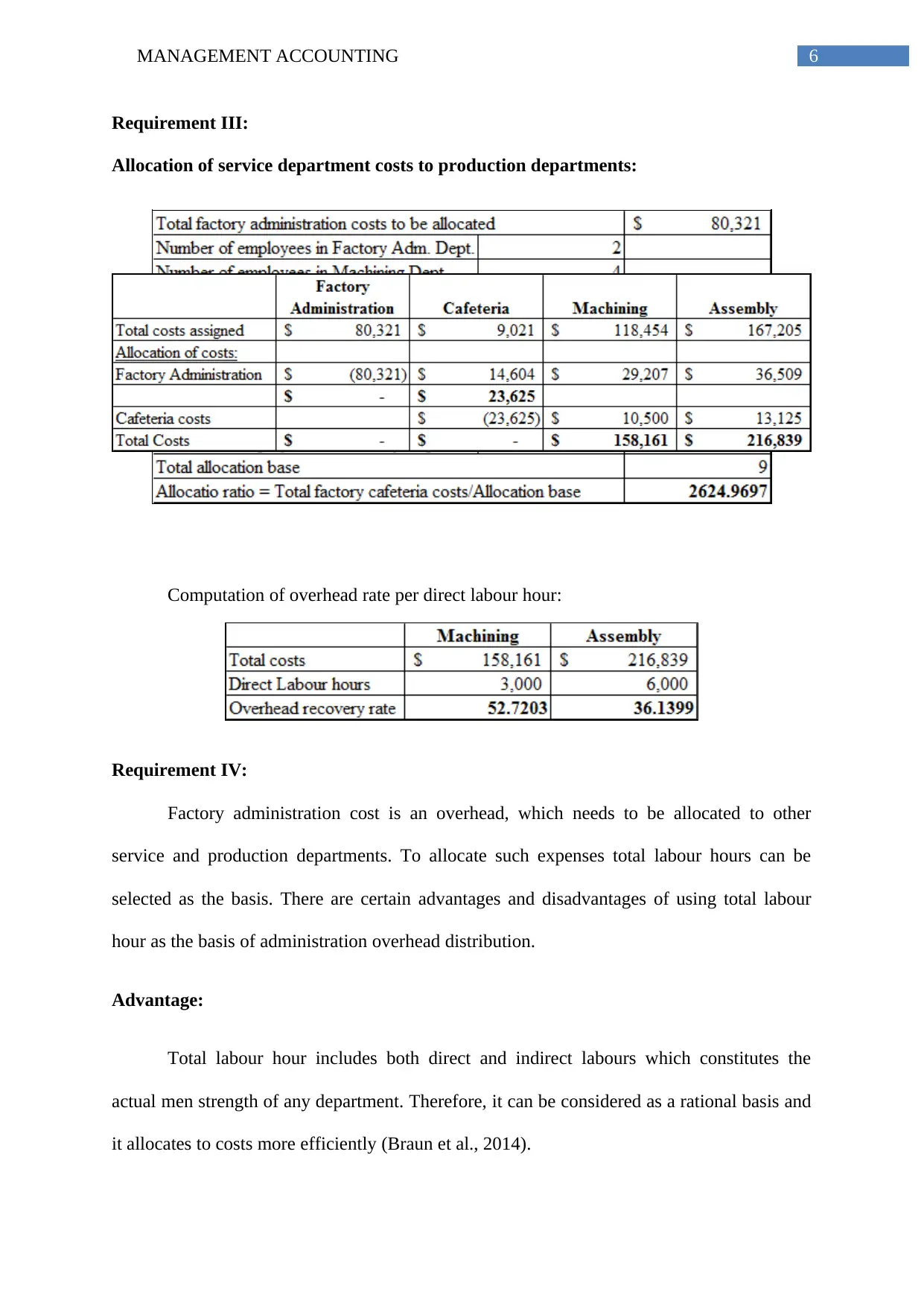
6MANAGEMENT ACCOUNTING
Requirement III:
Allocation of service department costs to production departments:
Computation of overhead rate per direct labour hour:
Requirement IV:
Factory administration cost is an overhead, which needs to be allocated to other
service and production departments. To allocate such expenses total labour hours can be
selected as the basis. There are certain advantages and disadvantages of using total labour
hour as the basis of administration overhead distribution.
Advantage:
Total labour hour includes both direct and indirect labours which constitutes the
actual men strength of any department. Therefore, it can be considered as a rational basis and
it allocates to costs more efficiently (Braun et al., 2014).
Requirement III:
Allocation of service department costs to production departments:
Computation of overhead rate per direct labour hour:
Requirement IV:
Factory administration cost is an overhead, which needs to be allocated to other
service and production departments. To allocate such expenses total labour hours can be
selected as the basis. There are certain advantages and disadvantages of using total labour
hour as the basis of administration overhead distribution.
Advantage:
Total labour hour includes both direct and indirect labours which constitutes the
actual men strength of any department. Therefore, it can be considered as a rational basis and
it allocates to costs more efficiently (Braun et al., 2014).
Paraphrase This Document
Need a fresh take? Get an instant paraphrase of this document with our AI Paraphraser

7MANAGEMENT ACCOUNTING
Disadvantage:
There are 500 total labour hours in the administration department itself. Rationally, a
part of the total administration costs needs to be allocated to the administration department
itself, which is a disadvantage of this system (Mihăilă, 2014).
Requirement V:
If some of the machining activities are outsourced, then direct labour hours in the
machining department would be reduced. As a result, the overhead expenses of the
department would be lower as well. However, certain points to be kept in mind for a
profitable outsourcing of activities, which are –
Direct labour costs of the in-house production must be considered. Total outsourcing
costs of the activity must be lesser than the direct labour costs.
Whether other fixed costs are incurred irrespective of the outsourcing, needs to be
considered.
Requirement VI:
From the management’s decision and explanation, it can be observed that they are
using direct labour hour as the basis for overhead allocation. If they outsource some the
machining department’s activities, then no overhead would be allocated to the machining
department, as there will be no direct labour hour (Weygandt, Kimmel & Kieso, 2015).
Hence, the total overhead would be allocated to other departments. The share of overhead,
which would have been allocated to the machining department, will be allocated to other
departments too.
As a whole the company is incurring the same amount of overhead, the only
difference is that no overhead is allocated to the machining department. So, it cannot be
Disadvantage:
There are 500 total labour hours in the administration department itself. Rationally, a
part of the total administration costs needs to be allocated to the administration department
itself, which is a disadvantage of this system (Mihăilă, 2014).
Requirement V:
If some of the machining activities are outsourced, then direct labour hours in the
machining department would be reduced. As a result, the overhead expenses of the
department would be lower as well. However, certain points to be kept in mind for a
profitable outsourcing of activities, which are –
Direct labour costs of the in-house production must be considered. Total outsourcing
costs of the activity must be lesser than the direct labour costs.
Whether other fixed costs are incurred irrespective of the outsourcing, needs to be
considered.
Requirement VI:
From the management’s decision and explanation, it can be observed that they are
using direct labour hour as the basis for overhead allocation. If they outsource some the
machining department’s activities, then no overhead would be allocated to the machining
department, as there will be no direct labour hour (Weygandt, Kimmel & Kieso, 2015).
Hence, the total overhead would be allocated to other departments. The share of overhead,
which would have been allocated to the machining department, will be allocated to other
departments too.
As a whole the company is incurring the same amount of overhead, the only
difference is that no overhead is allocated to the machining department. So, it cannot be
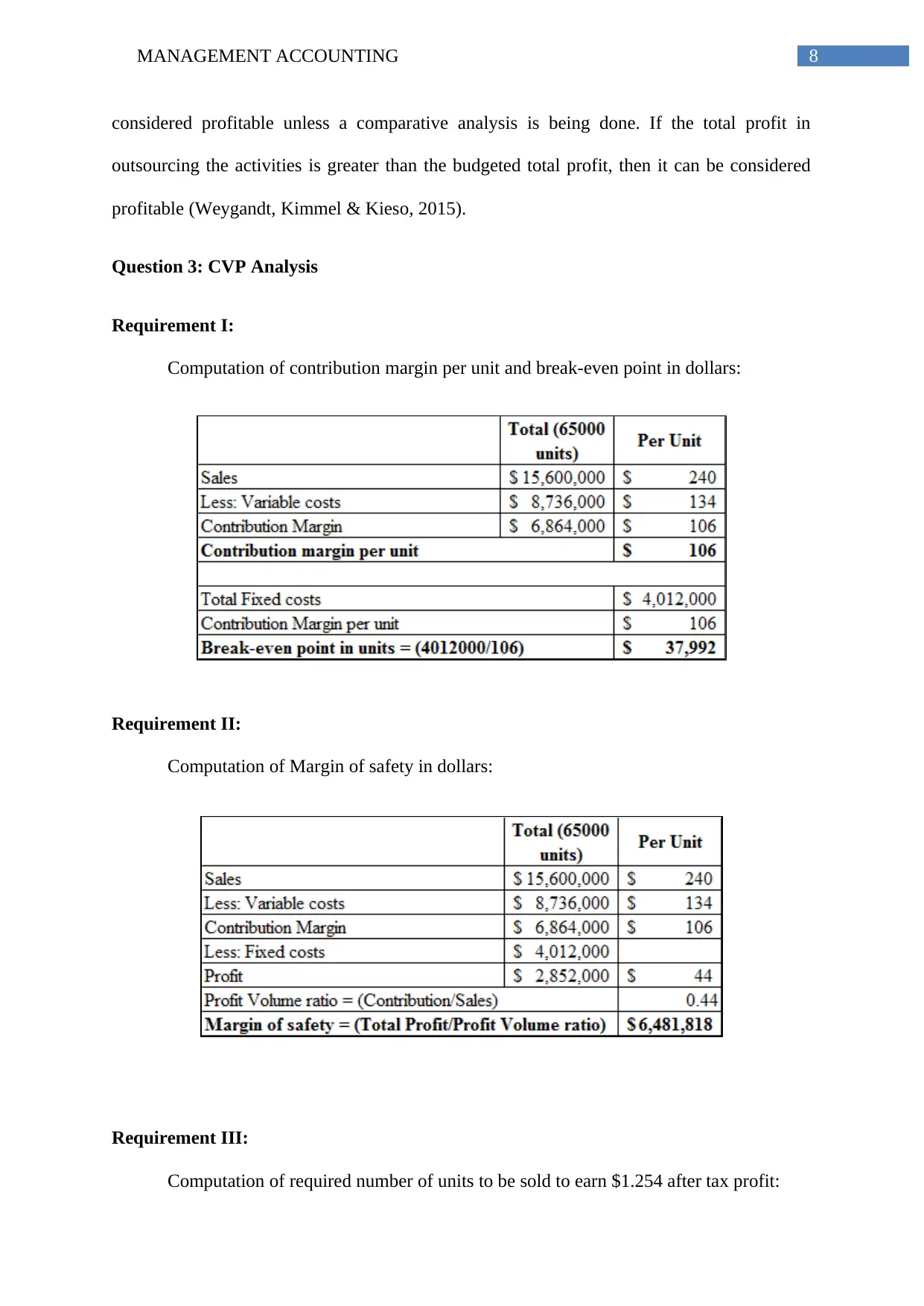
8MANAGEMENT ACCOUNTING
considered profitable unless a comparative analysis is being done. If the total profit in
outsourcing the activities is greater than the budgeted total profit, then it can be considered
profitable (Weygandt, Kimmel & Kieso, 2015).
Question 3: CVP Analysis
Requirement I:
Computation of contribution margin per unit and break-even point in dollars:
Requirement II:
Computation of Margin of safety in dollars:
Requirement III:
Computation of required number of units to be sold to earn $1.254 after tax profit:
considered profitable unless a comparative analysis is being done. If the total profit in
outsourcing the activities is greater than the budgeted total profit, then it can be considered
profitable (Weygandt, Kimmel & Kieso, 2015).
Question 3: CVP Analysis
Requirement I:
Computation of contribution margin per unit and break-even point in dollars:
Requirement II:
Computation of Margin of safety in dollars:
Requirement III:
Computation of required number of units to be sold to earn $1.254 after tax profit:
⊘ This is a preview!⊘
Do you want full access?
Subscribe today to unlock all pages.

Trusted by 1+ million students worldwide
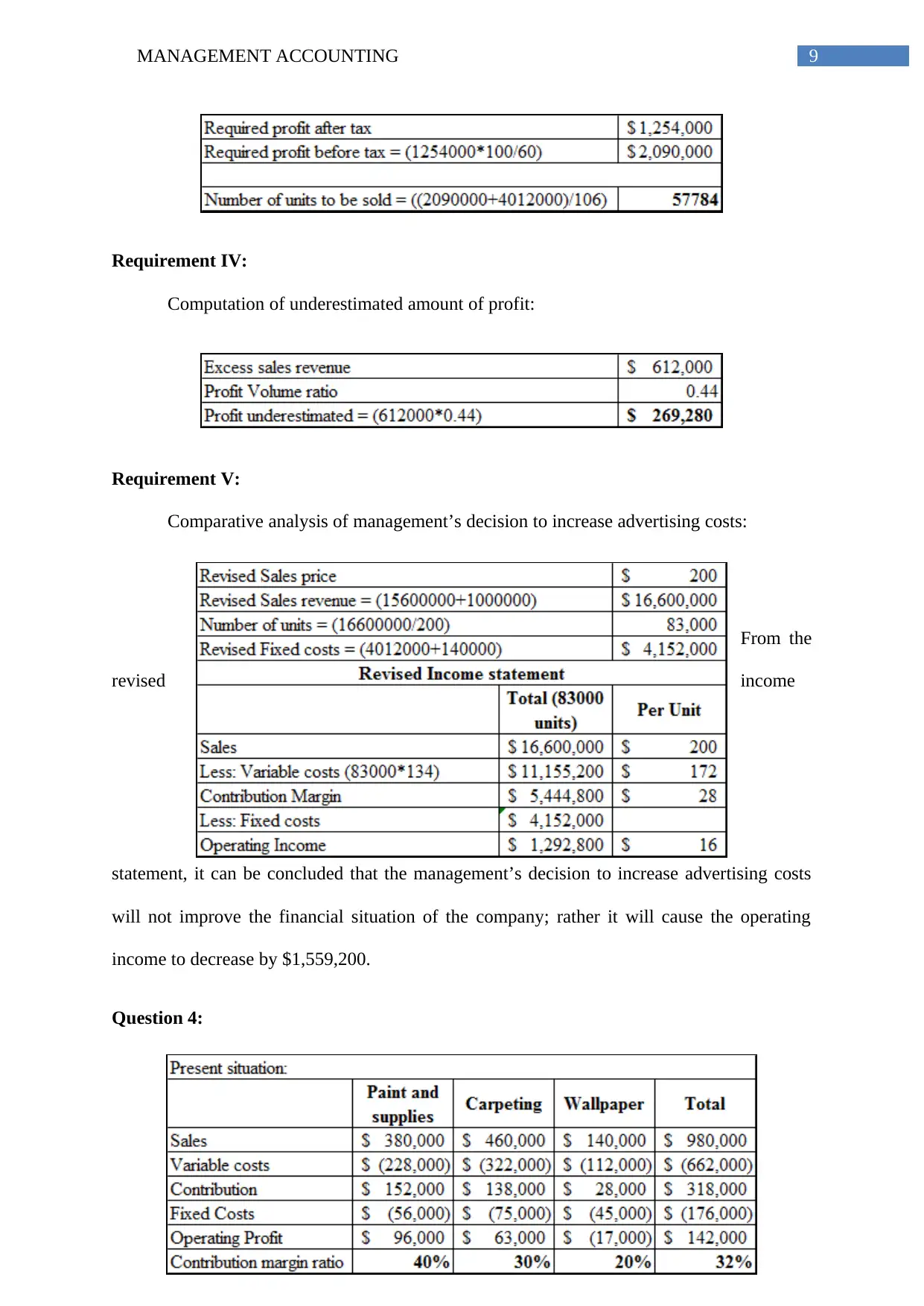
9MANAGEMENT ACCOUNTING
Requirement IV:
Computation of underestimated amount of profit:
Requirement V:
Comparative analysis of management’s decision to increase advertising costs:
From the
revised income
statement, it can be concluded that the management’s decision to increase advertising costs
will not improve the financial situation of the company; rather it will cause the operating
income to decrease by $1,559,200.
Question 4:
Requirement IV:
Computation of underestimated amount of profit:
Requirement V:
Comparative analysis of management’s decision to increase advertising costs:
From the
revised income
statement, it can be concluded that the management’s decision to increase advertising costs
will not improve the financial situation of the company; rather it will cause the operating
income to decrease by $1,559,200.
Question 4:
Paraphrase This Document
Need a fresh take? Get an instant paraphrase of this document with our AI Paraphraser

10MANAGEMENT ACCOUNTING
CK was
incurring a huge amount of loss on their Wallpaper segment. After closing the Wallpaper
segment and extending the carpeting segment using the facilities of wallpaper segment, the
company can make some extra profit. Therefore, it would be beneficial for the company to
drop the wallpaper segment.
Requirement II:
Decision regarding keep and drop of a particular segment of a company depends on
certain quantitative and qualitative factors. Quantitative factors mostly include profits and
financial performance of the business. On the other hand, qualitative factor includes the
quality of the products, which is produced using the existing facilities, customers’ needs and
demands, employees’ interest and suppliers’ interest. Some of the qualitative factors can be
elaborated as below (Butler & Ghosh, 2015).
Quality of the Products:
Quality of the products, which are being produced using the facilities of the dropped
segment, may not be as good as is expected. Extension of a product line must be done
without affecting the quality of the product.
CK was
incurring a huge amount of loss on their Wallpaper segment. After closing the Wallpaper
segment and extending the carpeting segment using the facilities of wallpaper segment, the
company can make some extra profit. Therefore, it would be beneficial for the company to
drop the wallpaper segment.
Requirement II:
Decision regarding keep and drop of a particular segment of a company depends on
certain quantitative and qualitative factors. Quantitative factors mostly include profits and
financial performance of the business. On the other hand, qualitative factor includes the
quality of the products, which is produced using the existing facilities, customers’ needs and
demands, employees’ interest and suppliers’ interest. Some of the qualitative factors can be
elaborated as below (Butler & Ghosh, 2015).
Quality of the Products:
Quality of the products, which are being produced using the facilities of the dropped
segment, may not be as good as is expected. Extension of a product line must be done
without affecting the quality of the product.
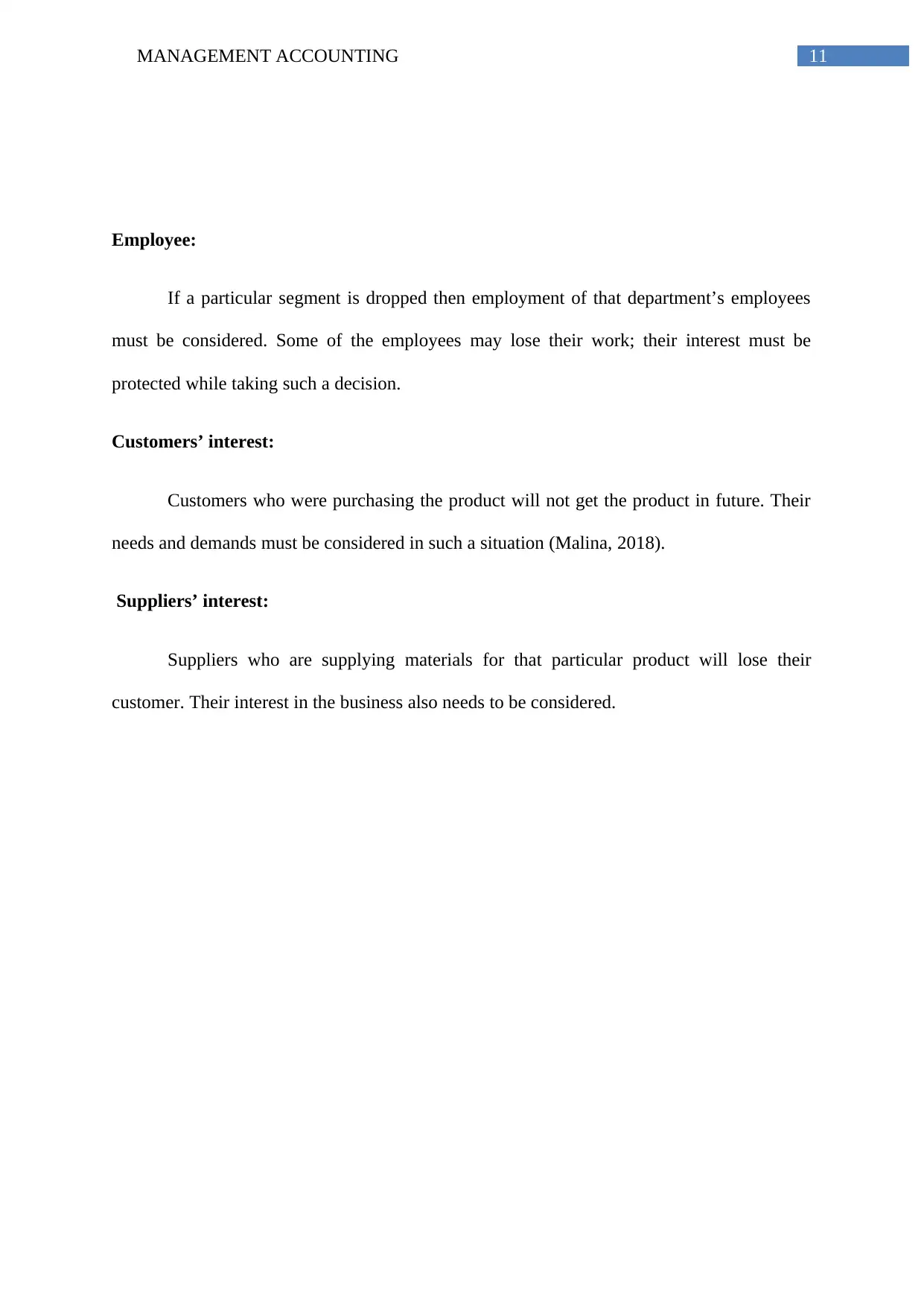
11MANAGEMENT ACCOUNTING
Employee:
If a particular segment is dropped then employment of that department’s employees
must be considered. Some of the employees may lose their work; their interest must be
protected while taking such a decision.
Customers’ interest:
Customers who were purchasing the product will not get the product in future. Their
needs and demands must be considered in such a situation (Malina, 2018).
Suppliers’ interest:
Suppliers who are supplying materials for that particular product will lose their
customer. Their interest in the business also needs to be considered.
Employee:
If a particular segment is dropped then employment of that department’s employees
must be considered. Some of the employees may lose their work; their interest must be
protected while taking such a decision.
Customers’ interest:
Customers who were purchasing the product will not get the product in future. Their
needs and demands must be considered in such a situation (Malina, 2018).
Suppliers’ interest:
Suppliers who are supplying materials for that particular product will lose their
customer. Their interest in the business also needs to be considered.
⊘ This is a preview!⊘
Do you want full access?
Subscribe today to unlock all pages.

Trusted by 1+ million students worldwide
1 out of 13
Related Documents
Your All-in-One AI-Powered Toolkit for Academic Success.
+13062052269
info@desklib.com
Available 24*7 on WhatsApp / Email
![[object Object]](/_next/static/media/star-bottom.7253800d.svg)
Unlock your academic potential
Copyright © 2020–2025 A2Z Services. All Rights Reserved. Developed and managed by ZUCOL.




